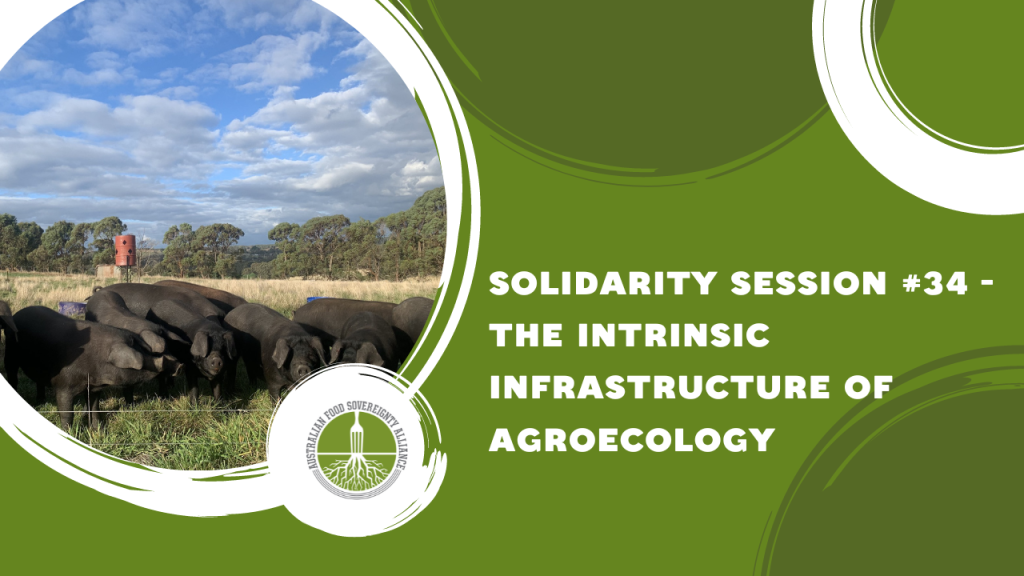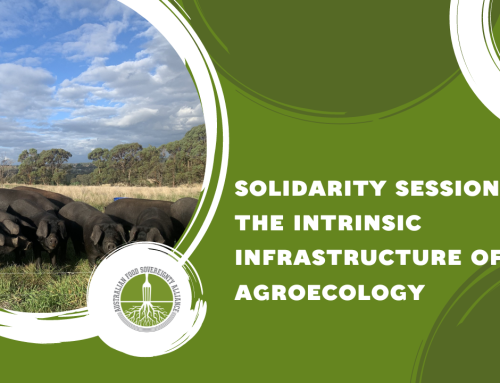Last Monday evening, ABC’s Four Corners aired a deep dive into Australia’s two largest supermarket chains, Coles and Woolworths, shedding light on price gouging tactics that are leaving both farmers and eaters out of pocket.
AFSA has long been critical of the ColesWorth duopoly’s stronghold on our food system. In both the updated Peoples’ Food Plan and our latest book Eating Democracy, we share critical insights into the market share of Coles and Woolworths, as well as the problems associated with having major control over production, supply and consumption of industrialised food. Here’s a snippet from Eating Democracy that explains the problem(s) with the duopoly.
Coles and Woolworths are the two major players that control 66 percent of Australia’s retail grocery market. The illusion of choice regarding which supermarket to shop at positions Woolworths first, where 48 percent of Australians primarily shop for their groceries, followed by Coles (39 percent), Aldi (ten percent), IGA (two percent) and Other (two percent).
In Stuffed and Starved, Raj Patel (2007: 217) offers an insightful chapter on modern supermarkets, where he defines them as ‘a large company, able to bargain down supplier prices, able to ensure that shelves are never empty, specialising in logistics and marketing.’ This definition can easily be applied to the Australian context:
Large company: together, the duopoly has more than 3,000 shops around the country, and in many areas, especially in outer suburban, regional and remote areas, these supermarkets are the only (easily apparent) option to source food. For a significant number of people around Australia, supermarkets are the main point of contact between them and the food they eat.
Able to bargain down supplier prices: due to their size, these corporations can bargain down supplier prices, which can result in a series of social and economic injustices for farmers, in addition to increasing waste and unsustainable practices. The demands for cheap, perfect looking, and abundant produce all year round can put enormous pressure on growers, and in many cases push them to use more chemicals, GMO seeds, pesticides, and fertilisers in the endless pursuit of increased productivity, damaging the land and becoming more costly to farmers with flow on negative impacts on worker rights.
Able to ensure shelves are never empty: supermarkets create an illusion of availability and abundance that does not represent the way food grows, or where it grows. Supermarkets have made us accustomed and confident that certain ingredients will ‘always’ be available, despite the current season, or where we are located. Capsicum, tomatoes, berries, beans, bread, milk, chicken, pork and bananas are only some examples of products expected to be conveniently available all year and everywhere. Under the illusion of availability, we may ignore not only how food is grown and where it comes from, but also how climate (fires, floods, draughts) and health crises (pandemic) impact such availability in terms of production and transportation. In fact, as Patel (2007) explains, for these corporations, the more disconnected the customer is from the producer, the better it is for their business.
Specialising in logistics and marketing: to ensure constant availability across the country, including numerous remote areas, large supermarkets use complex logistics to ensure shops are stocked up. These transportation systems disregard and obscure food miles and seasonality. Mangoes grown in Darwin are transported to Adelaide to be processed, and then transported back to Coles in Darwin. It doesn’t matter the season or current climate conditions, one will always find bananas, potatoes, and tomatoes in Central Victoria. Some products will also be ‘on special’ at the same time, in different states and locations, which feeds into the illusion of availability.
Through the use of strong marketing strategies, the Coles-Woolworths duopoly control not only the production, distribution and supply of food through the country, but also induce customers to believe that their prices are the cheapest, when in fact, they are not. As unpacked by The Guardian, fruit and vegetable prices can actually be more expensive in supermarkets when compared to smaller, independent shops.
Both major supermarkets made boom profits during the pandemic, a challenging time for most people, as we uncovered in our survey. According to reported operating margins, profitability spiked to 5.3 percent at Coles and 5.9 percent at Woolworths during Covid. The Guardian Australia revealed that Coles and Woolworths have boosted profit margins throughout the pandemic and inflationary period, unlike European counterparts who have faltered due to greater market competition.
Unpacking the relationship between Australians and supermarkets, and the dynamics through which supermarkets source and distribute food, deepens our understanding of how these create a series of barriers for us to eat democratically.
So, how do we take the power back? For both farmers and eaters, here are some tips from our updated Peoples’ Food Plan that offer a guide on how we can collectively transform the food system away from the capitalist, industrial model.
Collectivise, organise, act!
- Small-scale farmers and other independent food producers (eg. bakers, butchers) can collectivise to set up local processing and distribution systems for your region.
- Form a collective to represent smallholders in local and state government fora, and form an alliance with AFSA.
- Advocate to government to reduce barriers to locally owned distribution models (in planning schemes, food safety regimes, etc)
- Become an AFSA member. Whether you’re a farmer, food activist or new to the movement, your support can help AFSA fight for socially-just and ecologically-sound food and agricultural systems for all.
- Form local collectives and advocate to all levels of government supporting the recommendations and policy positions outlined in AFSA’s Peoples’ Food Plan (see the Value Chain section).
Collectivise for direct distribution models
|
|
|
|
|
|
|
|
|
|
|
|
|
|
Following on from ABC’s Four Corners episode, AFSA will continue to fight for food sovereignty on behalf of farmers and eaters across the country. If you’re a farmer who’s been impacted by the ColesWorth duopoly, or an eater who’s feeling the pinch of rising grocery bills, please email us! We’d love to hear from you to find out how AFSA can best keep this conversation going.
In the meantime, find out more about how you can get involved in radical food system transformation by:
- Becoming an AFSA member
- Reading our books: Farming Democracy (2019) and Eating Democracy (2023)






